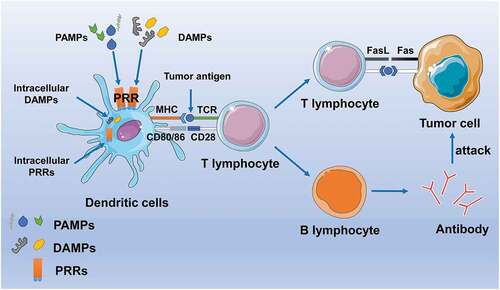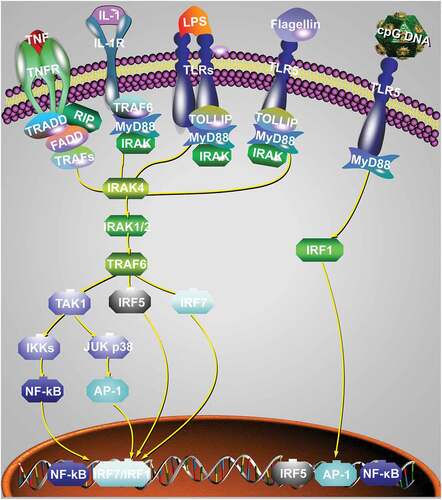Figures & data
Figure 1. Schematic expression of several PAMP and DAMP signals. TLR and IL-1 R usually share a common signaling event. PAMP and DAMP bind to corresponding ligands, TLR dimer forms a homodimer or heterodimer, and conformational changes occur. MyD88 was the first adaptor molecule to be identified and is involved in all TLR (except TLR3)-induced signal transduction.MyD88 relies on a pathway to initiate a series of events that lead to the activation of IRAK kinase, which leads to the activation of NF-κB transcription factor and the expression of the pro-validation factor gene. In response to TLR stimulation, the MYD88-dependent pathway also activates the interferon regulatory factor (IRF) family of transcription factors IRF1, IRF5, or IRF7 phosphorylation mecha-intensity, which lead to formation of their translocated nuclei and bind to target interferon stimulation-responsive elements (ISRES) with the transcription co-activators association. IRF1 and IRF7 are involved in transcriptional control of type I interferon, while IRF5 is involved in the transcription of all pro-inflammatory cytokines tested to date by TLRs.

Table 1. Common DAMP receptors, downstream, and their roles in immunity
Table 2. Summary of vaccines with DAMPs and PAMPs and on going clinical trials results
Figure 2. Schematic expression of how PAMPs and DAMPs enhance the body’s anti-tumor immunity. PAMPs and DAMPs bind to PRR receptors in the APC membrane or cytoplasm and enhance APC activation and uptake of tumor antigens, presenting them to T cells to activate them. On the one hand, activated T cells induced apoptosis of tumor cells through the Fas/FasL pathway. On the other hand, they can also assist B cell activation to produce specific antibodies to destroy the tumor.

